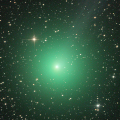
|
Brightening very rapidly. Now it is so bright as 5.6 mag (Dec. 20, Marco Goiato). It is visible with naked eyes. It will approach to the earth in December and January, and it is expected to brighten up to 4 mag. In the Southern Hemisphere, it keeps observable in excellent condition until late January. In the Northern Hemisphere, it keeps extremely low until mid December. But after that, it will be observable in excellent condition.
Date(TT) R.A. (2000) Decl. Delta r Elong. m1 Best Time(A, h)
Dec. 20 6 23.13 -36 46.2 0.662 1.430 119 5.7 0:33 ( 0, 88)
Dec. 27 5 39.21 -28 23.8 0.551 1.388 127 5.1 23:11 (180, 82)
|

|
It brightened up to 6.9 mag in autumn (Oct. 17, Marco Goiato). Now it is fading. But it is bright as 10.2 mag still now (Dec. 19, Chris Wyatt). It is observable in excellent condition in the Southern Hemisphere. In the Northern Hemisphere, it is observable in the evening low sky in December and January.
Date(TT) R.A. (2000) Decl. Delta r Elong. m1 Best Time(A, h)
Dec. 20 0 18.12 -38 11.1 1.970 2.058 80 9.9 20:59 ( 73, 58)
Dec. 27 0 11.98 -35 24.5 2.175 2.140 74 10.3 21:02 ( 75, 51)
|
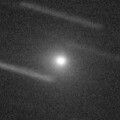
|
It brightened very rapidly in outburst. Now it is 8.8 mag (Dec. 19, Marco Goiato), brighter than this ephemeris by 2 mag. It keeps 9-10 mag until January. In the Northern Hemisphere, it will be geting higher gradually. In the Southern Hemisphere, it will be getting lower gradually, and it keeps extremely low after January.
Date(TT) R.A. (2000) Decl. Delta r Elong. m1 Best Time(A, h)
Dec. 20 20 51.02 -19 25.5 1.458 0.981 42 11.0 20:59 ( 74, 11)
Dec. 27 21 22.71 -16 25.1 1.428 0.976 42 10.5 21:02 ( 77, 9)
|
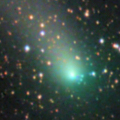
|
The brightness evolution has slowed down before the perihelion passage, and it faded down to 11.6 mag in late October (Oct. 26, Todd Augustyniak). However, an outburst occured around Nov. 10-12, and it brightened by 2 mag. It is bright as 10.4 mag still now (Nov. 29, Seiichi Yoshida). In the Northern Hemisphere, it became unobservable temporarily in December. But it will be observable in excellent condition after January while the comet will be fading. In the Southern Hemisphere, it will keep locating extremely low after this.
Date(TT) R.A. (2000) Decl. Delta r Elong. m1 Best Time(A, h)
Dec. 20 17 53.85 -2 38.0 2.493 1.611 20 10.6 20:59 ( 58,-34)
Dec. 27 17 56.49 -0 32.3 2.516 1.662 23 10.7 2:58 (296,-31)
|
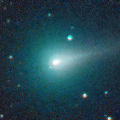
|
Now it is so bright as 10.9 mag (Dec. 20, Marek Biely). It keeps observable in the morning low sky at the same brightness for a while. In the Southern Hemisphere, it is too low to observe until December.
Date(TT) R.A. (2000) Decl. Delta r Elong. m1 Best Time(A, h)
Dec. 20 14 33.69 -7 5.6 1.838 1.420 49 11.9 2:54 (274, 7)
Dec. 27 14 54.95 -8 32.1 1.847 1.455 51 12.1 2:58 (274, 10)
|
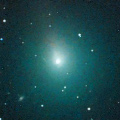
|
It brightened rapidly, and reached up to 10.3 mag in autumn (Oct. 22, Bob King). Now it is fading, but it is bright as 12.1 mag still now (Nov. 29, Seiichi Yoshida). In the Northern Hemisphere, it keeps observable in good condition until the comet will fade out in next spring. It is not observable in the Southern Hemisphere.
Date(TT) R.A. (2000) Decl. Delta r Elong. m1 Best Time(A, h)
Dec. 20 18 59.18 51 28.7 1.631 1.696 76 12.2 20:59 (130,-44)
Dec. 27 19 7.47 48 38.1 1.732 1.719 72 12.6 21:02 (126,-47)
|
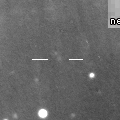
|
It will brighten up to 8-9 mag in 2015 spring. In the Southern Hemisphere, it will become observable in January, then it keeps observable in good condition after that. In the Northern Hemisphere, it keeps extremely low and hard to observe from December to 2015 June. It will be observable in good condition after June while the comet will be fading gradually.
Date(TT) R.A. (2000) Decl. Delta r Elong. m1 Best Time(A, h)
Dec. 20 15 47.94 -19 16.3 2.567 1.769 28 12.7 2:54 (294, -1)
Dec. 27 16 8.00 -20 24.9 2.492 1.726 31 12.4 2:58 (294, 2)
|
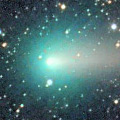
|
The brightness evolution has slowed down just before the perihelion passage. But it brightened up to 6.5 mag in September (Sept. 21, Marco Goiato). Now it is fading. It has faded down to 10.6 mag in October (Oct. 21, Chris Wyatt). It is appearing in the morning sky in the Northern Hemisphere. It will be observable in mid January also in the Southern Hemisphere. It keeps observable in good condition after this, while the comet will be fading gradually.
Date(TT) R.A. (2000) Decl. Delta r Elong. m1 Best Time(A, h)
Dec. 20 16 0.47 -5 39.9 2.437 1.683 31 12.7 2:54 (285,-11)
Dec. 27 16 1.76 -4 26.5 2.446 1.786 38 13.0 2:58 (280, -6)
|
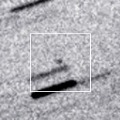
|
It will brighten very rapidly, and will brighten up to 11 mag from January to February. In the Southern Hemisphere, it will be observable in the morning sky after late February while the comet will be fading. It is hardly observable in the Northern Hemisphere.
Date(TT) R.A. (2000) Decl. Delta r Elong. m1 Best Time(A, h)
Dec. 20 16 28.78 -12 29.5 2.197 1.339 22 13.5 2:54 (295,-13)
Dec. 27 16 53.76 -14 22.8 2.162 1.309 22 13.0 2:58 (296,-10)
|
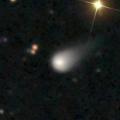
|
Now it is 13.6 mag (Dec. 19, Chris Wyatt). Getting brighter than originally expected, and it is already visible visually. It is expected to brighten up to 4 mag from autumn to winter in 2015. It is observable in good condition in the Southern Hemisphere until the highlight, or in the Northern Hemisphere after the highlight.
Date(TT) R.A. (2000) Decl. Delta r Elong. m1 Best Time(A, h)
Dec. 20 22 22.68 -25 10.5 4.971 4.582 61 13.6 20:59 ( 80, 31)
Dec. 27 22 23.55 -24 56.5 5.005 4.509 54 13.5 21:02 ( 76, 25)
|
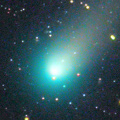
|
It brightened rapidly in outburst in mid October in 2013. Now it is fading. It has already faded down to 13.0 mag (Oct. 18, Con Stoitsis). In the Southern Hemisphere, it keeps observable in good condition for a long time until the comet fades out. In the Northern Hemisphere, it keeps extremely low after this.
Date(TT) R.A. (2000) Decl. Delta r Elong. m1 Best Time(A, h)
Dec. 20 22 32.30 -42 28.6 4.333 3.940 60 13.7 20:59 ( 61, 40)
Dec. 27 22 40.15 -41 36.6 4.469 4.006 56 13.9 21:02 ( 60, 35)
|
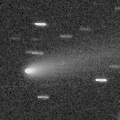
|
Now it is 13.9 mag (Nov. 29, Seiichi Yoshida). It is fainter than originally predicted by 2 mag. In the Northern Hemisphere, it keeps observable at 14 mag in excellent condition from 2014 summer to 2015 spring. It locates somewhat low in the Southern Hemisphere.
Date(TT) R.A. (2000) Decl. Delta r Elong. m1 Best Time(A, h)
Dec. 20 11 27.96 17 1.9 1.646 2.081 101 13.9 2:54 (223, 26)
Dec. 27 11 35.93 16 52.9 1.592 2.099 106 13.9 2:58 (218, 29)
|

|
Now it is not observable. It will appear in the morning sky again in January.
Date(TT) R.A. (2000) Decl. Delta r Elong. m1 Best Time(A, h)
Dec. 20 16 52.48 -29 33.4 7.033 6.085 14 14.1 2:54 (312, -5)
Dec. 27 16 58.69 -29 42.3 7.001 6.083 19 14.1 2:58 (308, -1)
|
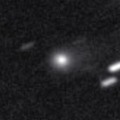
|
Now it is 14.8 mag (Sept. 16, Taras Prystavski). It is expected to brighten up to 13 mag and to be observable in good condition in 2015. It becomes unobservable temporarily from October to January.
Date(TT) R.A. (2000) Decl. Delta r Elong. m1 Best Time(A, h)
Dec. 20 16 40.72 -13 10.6 4.510 3.597 19 14.3 2:54 (298,-14)
Dec. 27 16 51.42 -13 25.4 4.460 3.580 23 14.3 2:58 (295,-10)
|
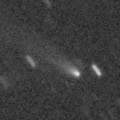
|
Now it is 14.8 mag (Dec. 12, Mike Wolle). It will be observable at 14 mag in excellent condition in winter.
Date(TT) R.A. (2000) Decl. Delta r Elong. m1 Best Time(A, h)
Dec. 20 23 37.43 -1 35.8 1.020 1.372 86 14.6 20:59 (115, 33)
Dec. 27 23 54.27 1 8.5 1.039 1.357 84 14.6 21:02 (115, 29)
|
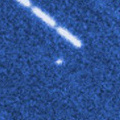
|
Now it is 18.2 mag (Nov. 17, J. Oey, P. Camilleri, H. Williams). It will brighten up to 9 mag in 2015 spring. But the condition of this apparition is bad. In the Southern Hemisphere, it keeps observable until winter when the comet will be 13 mag. But it is not observable around the brightest days. In the Northern Hemispehre, it keeps extremely low and hard to observe. It will be observable after 2015 autumn when the comet will fade out.
Date(TT) R.A. (2000) Decl. Delta r Elong. m1 Best Time(A, h)
Dec. 20 21 49.15 -39 22.0 2.636 2.179 52 15.1 20:59 ( 61, 31)
Dec. 27 22 2.95 -37 40.5 2.639 2.129 49 14.8 21:02 ( 62, 27)
|
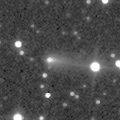
|
Now it is 14.7 mag (Nov. 28, Mt. Lemmon Survey). It keeps 15 mag until February, and it will be observable in excellent condition in the Northern Hemisphere. It locates somewhat low in the Southern Hemisphere.
Date(TT) R.A. (2000) Decl. Delta r Elong. m1 Best Time(A, h)
Dec. 20 6 53.26 26 43.5 1.511 2.475 165 14.9 1:01 (180, 28)
Dec. 27 6 47.08 26 12.6 1.496 2.476 173 14.9 0:28 (180, 29)
|
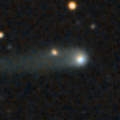
|
Now it is 14.9 mag (Nov. 22, Ken-ichi Kadota). It keeps 15 mag for a long time from 2014 to 2015. It is observable in excellent condition in 2014 in the Southern Hemisphere, or in 2015 in the Northern Hemisphere.
Date(TT) R.A. (2000) Decl. Delta r Elong. m1 Best Time(A, h)
Dec. 20 0 10.12 -19 45.8 3.885 3.950 86 14.9 20:59 (102, 51)
Dec. 27 0 10.65 -17 58.3 3.978 3.939 80 15.0 21:02 ( 99, 44)
|
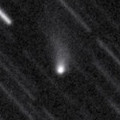
|
Now it is 16.1 mag (Nov. 13, J. Oey, P. Camilleri, H. Williams). The brightness evolution is somewhat slow. It keeps 15-16 mag for a long time from 2014 autumn to 2015 autumn. In the Southern Hemisphere, it keeps observable in excellent condition for a long time. In the Northern Hemisphere, it is unobservable until 2015 June.
Date(TT) R.A. (2000) Decl. Delta r Elong. m1 Best Time(A, h)
Dec. 20 6 39.99 -74 46.8 2.088 2.172 81 15.1 0:51 ( 0, 50)
Dec. 27 5 1.64 -76 9.8 2.085 2.141 79 15.1 22:28 ( 0, 49)
|
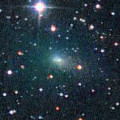
|
Now it is 13.7 mag (Nov. 29, Seiichi Yoshida). It will be observable at 14 mag in excellent condition from October to December.
Date(TT) R.A. (2000) Decl. Delta r Elong. m1 Best Time(A, h)
Dec. 20 5 8.87 37 27.5 0.847 1.812 163 15.1 23:13 (180, 17)
Dec. 27 5 4.23 38 16.5 0.886 1.834 157 15.3 22:41 (180, 17)
|

|
It brightened up to 11-12 mag in 2012. It has already faded down to 14.9 mag (Aug. 12, Taras Prystavski). Appearing in the morning sky again. It will be observable at 15 mag in good condition again in 2015.
Date(TT) R.A. (2000) Decl. Delta r Elong. m1 Best Time(A, h)
Dec. 20 12 8.45 -10 28.3 8.777 8.691 81 15.1 2:54 (254, 38)
Dec. 27 12 7.23 -10 32.4 8.688 8.728 89 15.1 2:58 (248, 45)
|
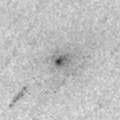
|
Now it is 15.5 mag (Oct. 28, Sandor Szabo). It keeps 15 mag from autumn to winter, but it is extremely diffuse. Moving southwards fast.
Date(TT) R.A. (2000) Decl. Delta r Elong. m1 Best Time(A, h)
Dec. 20 9 40.40 -18 56.8 1.404 1.968 109 15.2 2:54 (220, 70)
Dec. 27 9 37.64 -23 1.2 1.396 2.003 113 15.2 2:58 (200, 77)
|

|
Now it is 13.5 mag (Oct. 25, Seiichi Yoshida). It keeps bright as 13-14 mag for a long time from 2013 to 2014.
Date(TT) R.A. (2000) Decl. Delta r Elong. m1 Best Time(A, h)
Dec. 20 21 40.52 -21 52.7 3.819 3.317 52 15.3 20:59 ( 78, 21)
Dec. 27 21 49.37 -20 58.9 3.907 3.330 47 15.4 21:02 ( 76, 17)
|

|
Now it is 15.4 mag (Oct. 28, Sandor Szabo). It will brighten up to 14 mag from 2015 to 2016. It is observable in good condition in the Southern Hemisphere. It locates somewhat low in the Northern Hemisphere.
Date(TT) R.A. (2000) Decl. Delta r Elong. m1 Best Time(A, h)
Dec. 20 3 39.15 -23 16.4 4.093 4.707 123 15.3 21:42 (180, 78)
Dec. 27 3 29.65 -22 14.8 4.136 4.681 118 15.3 21:06 (180, 77)
|
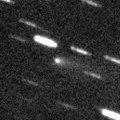
|
Now it is 14.0 mag and visible visually (Nov. 29, Seiichi Yoshida). It keeps observable for a long time after this while the comet will be fading gradually.
Date(TT) R.A. (2000) Decl. Delta r Elong. m1 Best Time(A, h)
Dec. 20 10 1.39 0 26.5 1.936 2.515 115 15.3 2:54 (210, 51)
Dec. 27 10 0.69 0 12.7 1.896 2.558 122 15.5 2:58 (198, 54)
|

|
Now it is 13.3 mag (Sept. 22, Seiichi Yoshida). It will be unobservable temporarily in winter, but it will be observable at 15-16 mag in good condition again in 2015.
Date(TT) R.A. (2000) Decl. Delta r Elong. m1 Best Time(A, h)
Dec. 20 18 36.50 -14 30.0 8.096 7.146 14 15.4 20:59 ( 57,-18)
Dec. 27 18 39.15 -14 48.2 8.141 7.173 9 15.4 21:02 ( 51,-22)
|
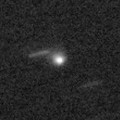
|
It will approach to the sun down to 0.3 a.u. in 2015 July, and it is expected to be bright. Now it is 16.0 mag (Nov. 15, Ken-ichi Kadota). It keeps observable while the comet will be brightening gradually until January when the comet will be 15 mag. The condition is bad after that and it will be hard to observe. But in the Southern Hemisphere, it will be observable after mid July in 2015, and keeps observable while the comet will be fading gradually. In the Northern Hemisphere, it is extremely hard to observe after 2015.
Date(TT) R.A. (2000) Decl. Delta r Elong. m1 Best Time(A, h)
Dec. 20 22 49.07 -24 18.8 3.713 3.456 67 15.7 20:59 ( 84, 36)
Dec. 27 22 51.19 -23 18.1 3.729 3.368 61 15.6 21:02 ( 81, 30)
|
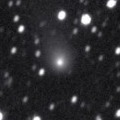
|
Now it is 14.2 mag (Oct. 4, Jakub Cerny). It keeps 13-14 mag and observable in good condition in the Northern Hemisphere for a long time from 2013 to 2014. It locates low in the Southern Hemisphere. Two fragments, B and C, are also visible at 18-20 mag.
Date(TT) R.A. (2000) Decl. Delta r Elong. m1 Best Time(A, h)
Dec. 20 22 38.25 19 53.3 4.750 4.722 82 15.6 20:59 (121, 8)
Dec. 27 22 40.51 18 43.5 4.906 4.763 75 15.7 21:02 (116, 4)
|
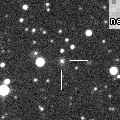
|
Now it is 15.7 mag (Nov. 13, A. Klotz, F. Kugel, J. Nicolas). In the Northern Hemisphere, it keeps 15-16 mag and observable in excellent condition for a long time until early summer in 2015. In the Southern Hemisphere, it is not observable until mid January.
Date(TT) R.A. (2000) Decl. Delta r Elong. m1 Best Time(A, h)
Dec. 20 13 10.02 32 46.8 3.469 3.561 87 15.7 2:54 (230, -1)
Dec. 27 13 16.54 32 41.6 3.405 3.573 91 15.7 2:58 (227, 2)
|
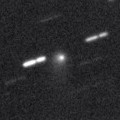
|
Now it is 15.5 mag (Nov. 29, Catalina Sky Survey). It keeps observable at 15-16 mag for a long time from 2015 to 2016. In the Northern Hemisphere, it is observable in excellent condition. It locates somewhat low in the Southern Hemisphere.
Date(TT) R.A. (2000) Decl. Delta r Elong. m1 Best Time(A, h)
Dec. 20 3 11.92 26 43.2 4.802 5.629 144 15.9 21:16 (180, 28)
Dec. 27 3 7.47 27 5.4 4.857 5.609 136 15.9 21:02 (175, 28)
|
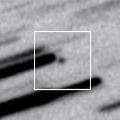
|
Now it is 15.3 mag (Nov. 27, Mt. Lemmon Survey). It will pass the perihelion on Mar. 15. In the Northern Hemispehre, it keeps observable in good condition until late February. In the Southern Hemisphere, it keeps observable until mid February, but it locates low.
Date(TT) R.A. (2000) Decl. Delta r Elong. m1 Best Time(A, h)
Dec. 20 2 23.49 29 7.0 0.763 1.608 133 15.9 20:59 (172, 26)
Dec. 27 2 1.28 25 18.8 0.773 1.534 121 16.1 21:02 (158, 27)
|
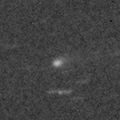
|
Now it is 16.6 mag (Nov. 19, Catalina Sky Survey). It will brighten up to 16 mag and will be observable in excellent condition in winter.
Date(TT) R.A. (2000) Decl. Delta r Elong. m1 Best Time(A, h)
Dec. 20 11 44.34 5 29.4 1.756 2.066 93 16.3 2:54 (235, 32)
Dec. 27 11 53.39 5 3.1 1.694 2.080 98 16.2 2:58 (230, 36)
|
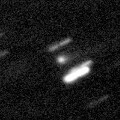
|
Now it is 16.2 mag (Nov. 24, Mt. Lemmon Survey). It will brighten up to 16 mag in winter, and will be observable in excellent condition.
Date(TT) R.A. (2000) Decl. Delta r Elong. m1 Best Time(A, h)
Dec. 20 8 25.17 12 54.2 3.265 4.084 141 16.3 2:33 (180, 42)
Dec. 27 8 22.75 12 49.9 3.209 4.086 149 16.3 2:03 (180, 42)
|
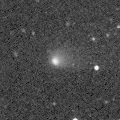
|
It is bright as 14.1 mag still now (Oct. 25, Seiichi Yoshida). It will be fading after this. But it keeps observable until March when it becomes fainter than 18 mag.
Date(TT) R.A. (2000) Decl. Delta r Elong. m1 Best Time(A, h)
Dec. 20 0 6.93 -11 10.6 2.211 2.409 89 16.4 20:59 (112, 45)
Dec. 27 0 15.38 -10 4.5 2.309 2.424 84 16.5 21:02 (108, 40)
|
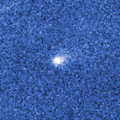
|
Now it is 15.9 mag (Nov. 29, Ken-ichi Kadota). It will be higher gradually, and will be observable at 16-17 mag in good condition from winter to spring. It will be observable after January also in the Southern Hemisphere.
Date(TT) R.A. (2000) Decl. Delta r Elong. m1 Best Time(A, h)
Dec. 20 14 44.85 -7 28.7 2.374 1.852 47 16.4 2:54 (276, 5)
Dec. 27 15 2.08 -8 21.7 2.340 1.866 49 16.4 2:58 (274, 8)
|
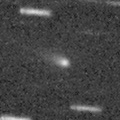
|
First return of a new periodic comet discovered in 2004. It brightened very rapidly as expected. Now it is 15.9 mag (Nov. 26, Catalina Sky Survey). It will be observable in excellent condition from autumn to winter.
Date(TT) R.A. (2000) Decl. Delta r Elong. m1 Best Time(A, h)
Dec. 20 0 23.71 6 47.4 0.903 1.450 100 16.4 20:59 (132, 35)
Dec. 27 0 46.76 7 24.8 0.958 1.473 98 16.7 21:02 (131, 34)
|

|
Now it is 16.8 mag (Nov. 15, J. F. Hernandez). It will pass close to the earth from spring to summer in 2016, and it is expected to be observable at 6-7 mag in good condition. In the Northern Hemispehre, it keeps observable in good condition until 2015 spring when the comet will brighten up to 15.5 mag. In the Southern Hemisphere, it keeps low for a long time until 2016 spring.
Date(TT) R.A. (2000) Decl. Delta r Elong. m1 Best Time(A, h)
Dec. 20 6 6.77 36 39.4 4.831 5.791 166 16.5 0:15 (180, 18)
Dec. 27 5 57.51 36 46.5 4.771 5.729 165 16.5 23:33 (180, 18)
|

|
Now it is 17.2 mag (Nov. 19, V. Luna). It will brighten up to 13 mag in 2016. In the Northern Hemisphere, it will be observable at 16 mag in excellent condition in this winter. It locates somewhat low in the Southern Hemisphere.
Date(TT) R.A. (2000) Decl. Delta r Elong. m1 Best Time(A, h)
Dec. 20 6 19.28 28 15.4 2.277 3.254 171 16.8 0:27 (180, 27)
Dec. 27 6 12.65 28 21.2 2.248 3.229 174 16.7 23:48 (180, 27)
|
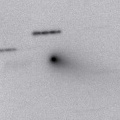
|
It brightened up to 13.8 mag from summer to autumn (Sept. 16, Taras Prystavski). Now it is fading rapidly. It has already faded down to 17.1 mag (Nov. 9, K. Hills). It keeps observable in good condition until February when the comet will be fainter than 18 mag.
Date(TT) R.A. (2000) Decl. Delta r Elong. m1 Best Time(A, h)
Dec. 20 0 19.85 -3 4.7 2.367 2.649 95 16.7 20:59 (123, 42)
Dec. 27 0 27.23 -2 11.9 2.487 2.682 90 16.9 21:02 (118, 37)
|
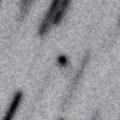
|
Now it is 16.8 mag (Dec. 13, K. Sarneczky). It keeps 17 mag until January, and it will be observable in excellent condition in the Northern Hemisphere.
Date(TT) R.A. (2000) Decl. Delta r Elong. m1 Best Time(A, h)
Dec. 20 5 2.80 45 1.2 0.882 1.826 156 17.0 23:06 (180, 10)
Dec. 27 4 55.41 47 32.3 0.898 1.819 150 17.0 22:32 (180, 7)
|

|
Now it is 16.9 mag (Nov. 18, R. Ligustri). It keeps 13 mag for a long time from 2015 to 2016, and will be observable in excellent condition in the Northern Hemisphere. In the Southern Hemisphere, it is observable only until mid 2015 March.
Date(TT) R.A. (2000) Decl. Delta r Elong. m1 Best Time(A, h)
Dec. 20 4 16.16 18 24.7 4.155 5.078 157 17.2 22:20 (180, 37)
Dec. 27 4 9.57 18 54.5 4.160 5.028 148 17.1 21:46 (180, 36)
|
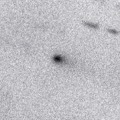
|
It brightened up to 14.6 mag in summer (July 8, Hidetaka Sato). Now it is fading. It has already faded down to 18.8 mag (Nov. 20, Yasukazu Ikari). It is fading much faster than predicted. The condition is good in the Northern Hemispehre. It locates somewhat low in the Southern Hemisphere.
Date(TT) R.A. (2000) Decl. Delta r Elong. m1 Best Time(A, h)
Dec. 20 8 38.85 13 32.2 1.550 2.382 139 17.2 2:46 (180, 42)
Dec. 27 8 33.55 13 53.9 1.539 2.426 147 17.3 2:14 (180, 41)
|
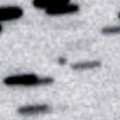
|
It keeps 17-18 mag for a long time from 2014 to 2016. Appearing in the morning sky again.
Date(TT) R.A. (2000) Decl. Delta r Elong. m1 Best Time(A, h)
Dec. 20 13 21.49 -20 39.7 5.735 5.341 61 17.3 2:54 (276, 29)
Dec. 27 13 20.11 -21 13.0 5.614 5.339 68 17.2 2:58 (272, 36)
|

|
First return of a peculiar asteroid 1998 HO121. It keeps observable at 17-18 mag from 2015 to 2016.
Date(TT) R.A. (2000) Decl. Delta r Elong. m1 Best Time(A, h)
Dec. 20 7 20.23 6 1.6 2.418 3.320 152 17.4 1:28 (180, 49)
Dec. 27 7 16.78 5 59.6 2.366 3.299 158 17.3 0:57 (180, 49)
|
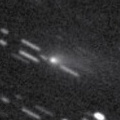
|
It brightened up to 2 mag by unusual major outburst in 2007. It brightened up to 12.6 mag in this apparition (June 25, Taras Prystavski). Now it is fading. It has already faded down to 16.3 mag (Dec. 2, Yasukazu Ikari). In the Northern Hemisphere, it keeps observable until it fades out in 2015. In the Southern Hemisphere, it keeps extremely low after this.
Date(TT) R.A. (2000) Decl. Delta r Elong. m1 Best Time(A, h)
Dec. 20 4 14.45 48 26.5 1.943 2.829 148 17.3 22:18 (180, 7)
Dec. 27 4 8.95 47 24.7 2.003 2.860 144 17.5 21:45 (180, 8)
|
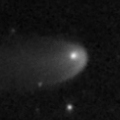
|
Now it is between 15.7 mag (Nov. 13, Yasukazu Ikari) and 19.1 mag (Nov. 25, A. Maury, J.-F. Soulier, J.-G. Bosch, T. Noel). Extremely diffuse, and hard to observe.
Date(TT) R.A. (2000) Decl. Delta r Elong. m1 Best Time(A, h)
Dec. 20 3 15.94 -3 37.8 8.583 9.289 133 17.3 21:20 (180, 59)
Dec. 27 3 13.55 -3 17.7 8.699 9.325 127 17.3 21:02 (174, 58)
|
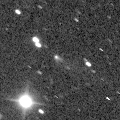
|
Now it is 18.9 mag (Nov. 20, Yasukazu Ikari). It was observed at 17 mag from 2013 to early 2014. It will be observable at 17.5 mag in good condition again from autumn to winter in 2014. But recently, it is fainter than this ephemeris.
Date(TT) R.A. (2000) Decl. Delta r Elong. m1 Best Time(A, h)
Dec. 20 8 38.78 12 44.8 2.513 3.317 138 17.3 2:46 (180, 42)
Dec. 27 8 35.82 12 42.7 2.467 3.331 146 17.3 2:16 (180, 42)
|
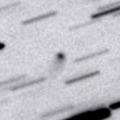
|
Now it is 16.8 mag (Sept. 11, E. Bryssinck). It keeps observable at 17-18 mag for a long time from 2013 to 2016. It keeps locating high in the Northern Hemisphere. It keeps locating very low in the Southern Hemipshere.
Date(TT) R.A. (2000) Decl. Delta r Elong. m1 Best Time(A, h)
Dec. 20 17 9.84 43 51.1 6.822 6.516 67 17.3 2:54 (241,-48)
Dec. 27 17 12.89 44 21.4 6.801 6.522 69 17.3 2:58 (239,-43)
|
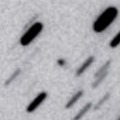
|
Now it is 17.5 mag (Nov. 29, Ken-ichi Kadota). It was observed around 17-18 mag in early 2014. It will be observable around 17-18 mag again from 2014 autumn to 2015 spring, in excellent condition in the Northern Hemisphere. It is not observable in the Southern Hemisphere.
Date(TT) R.A. (2000) Decl. Delta r Elong. m1 Best Time(A, h)
Dec. 20 10 57.31 55 22.3 4.618 5.134 116 17.4 2:54 (198, -4)
Dec. 27 10 57.30 55 46.4 4.564 5.138 120 17.4 2:58 (194, -3)
|
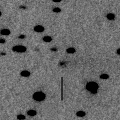
|
Now it is 17.1 mag (Nov. 22, Ken-ichi Kadota). It keeps observable at 17-18 mag from summer to winter in excellent condition in the Northern Hemisphere. It locates somewhat low in the Southern Hemisphere.
Date(TT) R.A. (2000) Decl. Delta r Elong. m1 Best Time(A, h)
Dec. 20 6 53.98 20 36.8 1.676 2.639 165 17.6 1:02 (180, 34)
Dec. 27 6 47.43 21 8.3 1.688 2.667 173 17.7 0:28 (180, 34)
|

|
It brightened up to 12-13 mag from 2012 to 2013. Now it is fading. But it is bright as 16.9 mag still now (Nov. 24, K. Hills). It keeps 16-17 mag until autumn, and will be observable in good condition.
Date(TT) R.A. (2000) Decl. Delta r Elong. m1 Best Time(A, h)
Dec. 20 0 17.27 -14 42.5 4.113 4.232 90 17.7 20:59 (110, 49)
Dec. 27 0 19.76 -13 55.4 4.234 4.248 84 17.8 21:02 (105, 43)
|
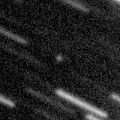
|
Peculiar asteroid with a cometary orbit of 45-years period. Now it is 18.3 mag (Oct. 4, M. Jaeger, et al.). It will brighten up to 17 mag from November to December, and will be observable in excellent condition.
Date(TT) R.A. (2000) Decl. Delta r Elong. m1 Best Time(A, h)
Dec. 20 3 24.98 5 0.8 1.983 2.812 140 17.7 21:28 (180, 50)
Dec. 27 3 10.40 2 41.0 2.102 2.831 129 17.9 21:02 (173, 52)
|
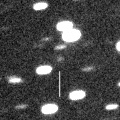
|
Now it is 19.6 mag (Dec. 2, A. Maury, J.-F. Soulier, J.-G. Bosch, T. Noel). Now it is around the aphelion. In the Northern Hemisphere, it is observable at 17.5 mag in good condition from winter to spring. It locates somewhat low in the Southern Hemisphere.
Date(TT) R.A. (2000) Decl. Delta r Elong. m1 Best Time(A, h)
Dec. 20 9 19.40 25 43.6 3.943 4.667 132 17.8 2:54 (188, 29)
Dec. 27 9 17.21 26 8.8 3.860 4.658 140 17.8 2:57 (180, 29)
|

|
Now it is 18.5 mag (Nov. 22, Mt. Lemmon Survey). It will brighten up to 11 mag in 2015 autumn. In this apparition, it is observable until the highlight while the comet is brightening.
Date(TT) R.A. (2000) Decl. Delta r Elong. m1 Best Time(A, h)
Dec. 20 12 39.33 -0 20.4 3.105 3.067 78 18.0 2:54 (251, 26)
Dec. 27 12 45.78 -0 49.7 2.967 3.028 84 17.8 2:58 (246, 31)
|
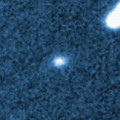
|
Now it is 17.6 mag (Dec. 1, A. Maury, T. Noel, J.-F. Soulier, J.-G. Bosch). It keeps observable at 17-18 mag in good condition from winter to spring.
Date(TT) R.A. (2000) Decl. Delta r Elong. m1 Best Time(A, h)
Dec. 20 9 22.81 12 6.1 2.984 3.678 128 18.0 2:54 (192, 42)
Dec. 27 9 21.99 11 43.7 2.891 3.659 135 17.9 2:58 (181, 43)
|
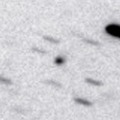
|
It keeps 18 mag from 2014 to 2015. In 2015, it keeps observable in good condition from winter to spring.
Date(TT) R.A. (2000) Decl. Delta r Elong. m1 Best Time(A, h)
Dec. 20 11 0.39 -6 39.2 5.667 5.896 98 18.0 2:54 (235, 48)
Dec. 27 11 0.72 -7 19.4 5.568 5.904 105 17.9 2:58 (226, 54)
|
|
![]()
 P/2014 L2 ( NEOWISE )
P/2014 L2 ( NEOWISE ) P/2014 X1 ( Elenin )
P/2014 X1 ( Elenin ) C/2014 W2 ( PanSTARRS )
C/2014 W2 ( PanSTARRS ) 16P/Brooks 2
16P/Brooks 2 C/2013 G9 ( Tenagra )
C/2013 G9 ( Tenagra ) (347449) 2012 TW236
(347449) 2012 TW236 17P/Holmes
17P/Holmes C/2009 F4 ( McNaught )
C/2009 F4 ( McNaught ) 119P/Parker-Hartley
119P/Parker-Hartley C/2012 K8 ( Lemmon )
C/2012 K8 ( Lemmon ) C/2013 U2 ( Holvorcem )
C/2013 U2 ( Holvorcem ) 191P/McNaught
191P/McNaught 246P/2010 V2 ( NEAT )
246P/2010 V2 ( NEAT ) 2013 NS11
2013 NS11 65P/Gunn
65P/Gunn 22P/Kopff
22P/Kopff C/2014 W11 ( PanSTARRS )
C/2014 W11 ( PanSTARRS ) C/2013 TW5 ( Spacewatch )
C/2013 TW5 ( Spacewatch )![]()




















































